Chapter: 11th Food Service Management : Practical: Chapter 7 : Menus and Cuisines
Types of Cuisines
Types of
Cuisines
A cuisine is a cooking style
denoting varieties of food prepared by a restaurant from a certain region or
country. There are different types of cuisines all over the world. Each country
or region has its own style.
Factors Affecting a Cuisine
·
A cuisine is frequently named after the region or
place where it is originated.
·
It is primarily influenced by the locally available
ingredients, the religion and the culture.
·
The area’s climate determines the native foods that
are available.
·
The trade
among different countries also largely affects a region’s cuisine.
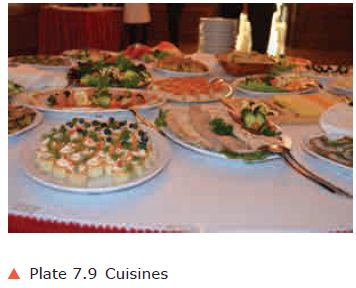
Common Cuisines
The common cuisines are Indian, International and fusion cuisine.
I. Indian Cuisines:
Indian cuisines are as diversified and unique as its culture and
country encompasses a wide variety of regional and traditional cuisines. Indian
food is often thought of as an ‘exotic cui-sine’ with charm of its own, it has
such a great variety of taste, colour and aroma.
II. Regional Cuisine:
It is based upon national, state or local regions. Regional
cuisines may vary based upon food availa-bility and trade, varying climates,
cooking traditions and practices and cultural dif-ferences. Each state has
evolved its very own cuisine influenced by the availabil-ity of certain raw
foods of the region. The cooking style varies from region to region and it is
largely divided into South Indian and North Indian cuisine.
Characteristic Features
·
Indian cuisine gives the range of diver-sity in
soil type, climate, culture, eth-nic group and occupations.
·
The staple food varies with region to region. In
the southern part of India, rice is the staple food while in the northern part
it is wheat.
·
There are special foods prepared for occasions like
festival in all the regions.
·
Indian cuisines use locally available spices,
herbs, vegetables and fruits.
·
A three meal balanced diet pattern is the most
common feature in Indian cuisine.
1. North Indian Cuisine: North India has extreme climates – summer is hot and winter is cold. To
quote a few, the region includes the following states: Jammu and Kashmir,
Himachal Pradesh, Punjab, Maharashtra, Madhya Pradesh.
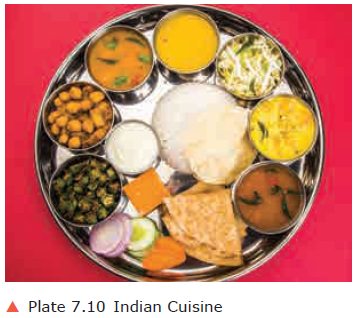
Characteristic Features
·
North
Indian cuisines usually have thick, moderately spicy and creamy gravies.
·
Use of
dried fruits and nuts is fairly common even in everyday foods.
·
Dairy
products like milk, cream, cot-tage cheese, ghee and yoghurt play an important
role in the cooking of both savory and sweet dishes.
·
This
region is famous for tandoori roti and naans, stuffed parathas and kulchas.
·
Basmati
rice in the form of jeera rice and pulaos are common.
·
Popular
dishes are mutter paneer, chaat, dhokla, dhalmakhani, samosas and so on.
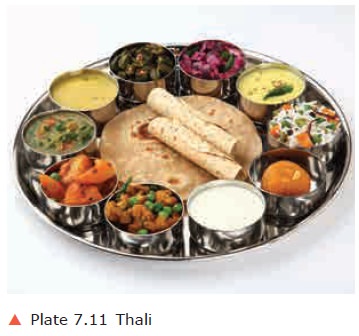
2. South
Indian Cuisine: South Indian cuisine includes the five southern states of
India: Andhra Pradesh, Karnataka, Kerala, Tamilnadu and Telungana.
Characteristic Features
·
Rice is a
staple food in South Indian Cuisine.
·
The
cuisines have common ingredients and differ primarily in the spiciness of the
food.
·
Millets
used commonly in rural areas are becoming popular in urban region too.
·
Some
authentic and popular South Indian dishes like pongal, sambar and vadai are
from Tamilnadu, rava idli from Karnataka, kadalai curry and appam from Kerala
and kebabs and biriyani from Andhra Pradesh.
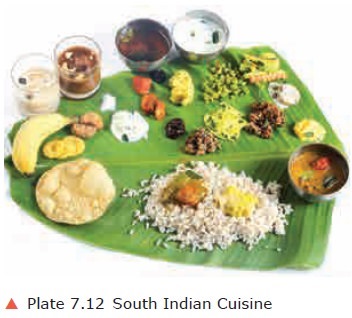
i. Tamil Nadu Cuisine
Characteristic Features
Variety of raw and parboiled rice as a sta-ple food, forms part of a
typical meal in Tamilnadu, accompanied with mildly or richly spiced vegetarian
and non-vegetar-ian dishes.
·
The various Tamil dishes can be cat-egorized in
different groups starting from the regular meals, the light meals, snacks and
desserts.
·
Mashed dhal with ghee, sambar, puli-kuzhambu,
rasam, kootu, kolisaaru, morkuzhambu and milagukuzhambu are the special dishes
of Tamil Nadu.
·
This cuisines conventionally include all the six
tastes that any food catego-rized into sweet, sour, salt, pungent, bitter and
astringent into the main meal so as to get complete nutrition and balanced
digestion.
In Tamil Nadu there are different
types of cuisines like Chettinad and Kongu. Some special foods like
Thirunelveli halwa, Kumbakonam degree filter coffee, Ambur biriyani,
Kanjeepuram idly, and Madurai Jigarthanda are also famous in Tamilnadu cuisine.

For example Traditional meals
served in Chettinad style on banana leaves follow a specific protocol. Each
dish has a designated space and order in which, it has to be served.
Serving of Food in Indian Cuisine
·
Etiquette
of Indian dining varies with the region in India.
·
Both in urban and rural settings Indi-ans wash
their hands thoroughly prior to dining, and then eat with their fin-gers,
without any cutlery.
·
Traditionally Indians sit on the floor while
eating.
·
Main dish
(rice or chappathi), sur-rounded with other dishes are served on ‘Thali’ – a
plate laid with banana leaf or stitched leaf.
·
There
will be dishes that are crunch, soft, dry, moist, rough and smooth.
·
Garnishes
are very simple such as sprinkling chopped coriander leaves or grated carrots
and nuts.
·
After a
meal, it is common to serve small cardamom seeds with their husks, aniseeds and
betel nuts.
III .International Cuisine:
International cuisine means the different cooking
prac-tices around the world. Each country has its own cuisine and each cuisine
is an art in itself. A global cuisine that is practiced around the world and
can be categorized according to the common use of major food stuffs. In order
to become a global cuisine a local, regional and national cuisine must spread around the
world.
There have been significant improvements and advances during the last
century in food preservation, storage, shipping and production and today many
countries, cities and regions have access to their traditional cuisines and
many other global cuisine.
![]()
Some of the most popular International cuisines include French, Chinese,
Italian and Mexican. Most coun-tries have a well-known famous dish or
ingredient that is associated with the cuisine.
Courses of Menu
In a full course menu, for
example in a French cuisine, the dinner consists of multiple dishes or courses.
In its simplest form, it consists of 3 or 4 courses such as appetizers, fish,
entrée (main course) and dessert.
1. French Cuisine
Characteristic Features
· Innovative flavours and elegant presentation.
·
Rich flavours with garlic, herbs, duck and
mushrooms.
·
French
cuisine is an unique cultural experience with nutritious foods with beauty.
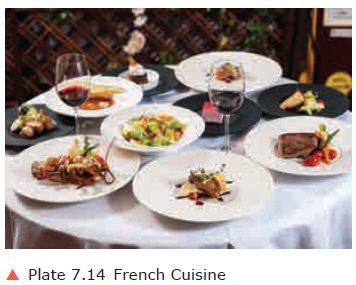
Serving of Foods in French Cuisine
·
Family
style is followed in serving food with all courses on the table at the same
line.
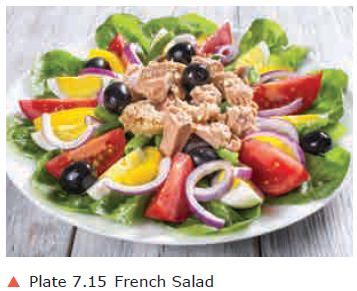
·
Continuous service of bread is fol-lowed till the
last course.
·
“Buffet” style is the variation of the French
service where all food is avail-able at the correct temperature in a serving
space other than dining table.
2. Chinese Cuisine
Characteristic Features
·
Chinese cooking calls for maximum preparations of
raw ingredients and minimum cooking methods.
·
The dishes have balance, combination and blend of
colour, flavour, texture, shape and size.
·
The Chinese sauté, steam, deep-fry and roast with a
difference.
·
Ingredients
are cut into beautiful shapes, yet flavor is never sacrificed.
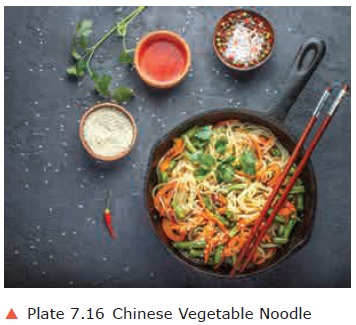
Serving of foods in Chinese Cuisine
·
It is considered inappropriate to use knives on the
dining table. Chopsticks are the main eating utensils.
·
Youth should not sit at the table before the
elders.
·
When eating with a bowl, one should not hold it
with its bottom part.
·
Waiters serve hot dishes one by one and usually
meat dishes are served first, then vegetables.
·
Rice / noodles are the staple dishes for Chinese
people.
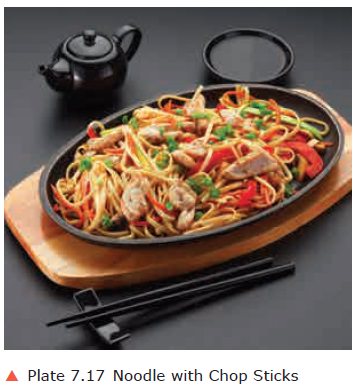
3. Italian Cuisine
Characteristic Features
·
Italian
food is extremely regional and varies greatly from region to region.
·
Light sea
food dishes, semolina and egg based pastas are served.
·
Simple
preparations and presentations. Heavy emphasis is given to quality of
ingredients.
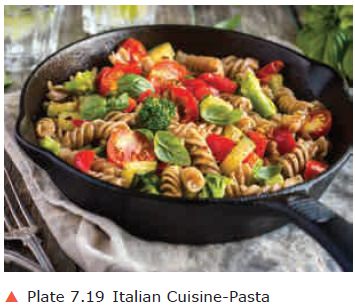
Serving of foods in Italian Cuisine
·
In
Italy, eating is
a moment of celebration where families, friends,
colleagues, get together, relax and par-ticipate in the dining ritual.
·
Even the most informal meals include multiple
courses.
·
The
various courses are a way to break down the meal into different sections, to
add variety and creativity.
IV. Fusion Cuisine
A combination of different traditional culinary cuisines is called fusion cuisine. Cuisines of this type are not categorized according to any one particular cuisine style and have played a part in innova-tions of many contemporary cuisines. Eg: Vegetable fried rice – Indo Chinese cuisine.
Related Topics